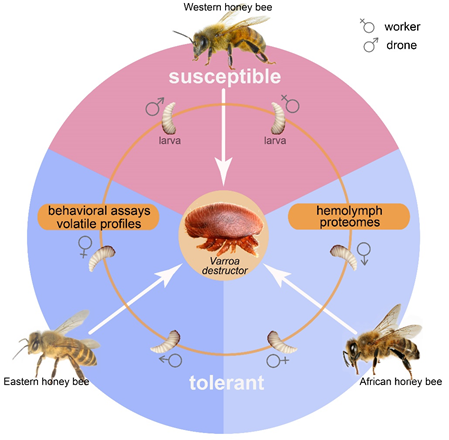A study revealing mechanisms of innate immune system in honey bees in response to infection with Varroa destructors
Date:2022-10-27
The Institute of Apicultural Research of Chinese Academy of Agricultural Sciences (IARCAAS) recently worked with the University of California,Riverside, and the Bahir Dar University, Ethiopia, in a preliminary analysis on the mechanisms of the innate immune system in honey bees in response to the infection with Varroa destructors. The study provided a theoretical basis for the in-depth understanding of the anti-mite molecular mechanisms of honey bees and the directive breeding of honey bees with the anti-mite properties. Relevant findings were published in Molecular & Cellular Proteomics.

Varroa destructors, a type of ectozoons that seriously threaten the health of honey bees, are the first factor causing the decline in the number of bee populations. Mite attacks have infested most bee populations worldwide and become a major challenge to the sound and sustainable development of the world’s apiculture. During the long-term co-existence with Varroa destructors, some bee populations have developed a series of mite tolerance properties, such as anti-mite Chinese honey bees, mite-resistant African honey bees and mite-susceptible Italian honey bees. The innate immune system is the most important defense system of animal organism, which is especially critical for honey bees lacking the adaptive immune system. Therefore, honey bees’ lymphatic fluid with different tolerance capacities is the key to understand the differences in their anti-mite capacities.
In the study, a series of interrelated experiments were conducted to analyze and compare the attraction of larvae of different honey bee species and classes to Varroa destructors based on the behavior. The findings showed that regardless of larval sex or bee species, six-day-old larvae were always the most attractive to Varroa destructors. Subsequently, volatiles of the most attractive larvae were compared to determine whether they were selected as the hosts by Varroa destructors. The study found that larvae of different ages varied in the abundance of volatile compounds, and these compounds were different significantly among various honey bee species and classes. Proteomic means were used to explain the physiological differences between potentially resistant and susceptible host larvae, and compare hemolymph proteomes of larvae of three honey bee species and two honey bee classes parasitized by Varroa destructors. According to the findings, larvae parasitized by Varroa destructors showed high expressions in both immunoreaction and stress reaction-related genes uniformly, and honey bee species tolerant to Varroa destructorshad a stronger immunoreaction. This study provided not only basic data on the innate immune system in honey bees in response to the infection with Varroa destructors, but also a theoretical basis for directive breedingof honey bees with anti-mite properties in the future.